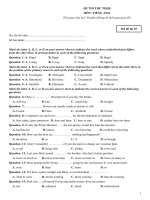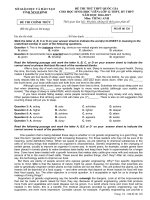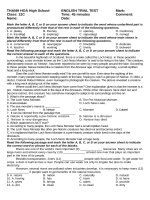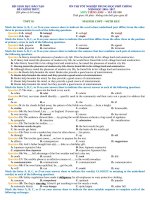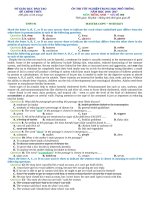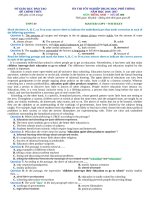12 bhh đề thi thử ts10 2223
Bạn đang xem bản rút gọn của tài liệu. Xem và tải ngay bản đầy đủ của tài liệu tại đây (110.38 KB, 10 trang )
BINH HUNG HOA SECONDARY SCHOOL
THE ENTRANCE TEST
I. Choose the word or phrase (A, B, C or D) that best fits the space in each sentence. (3.5 pts)
1. Which word has the underlined part pronounced differently from that of the others?
A. active
B. native
C. disaster
D. campus
2. Which word has the underlined part pronounced differently from that of the others?
A. shoes
B. languages
C. dishes
D. matches
3. Which word has a different stress pattern from that of the others?
A. organize
B. decorate
C. prediction
D. celebrate
4. Which word has a different stress pattern from that of the others?
A. engineer
B. understand
C. government
D. volunteer
5. Farmers usually use
to kill insects and weeds.
A. dynamite
B. bags
C. power
D. pesticides
6. We cannot deny the
of the Internet in our life.
A. controls
B. benefits
C. purposes
D. websites
7. I wouldn’t leave the class without a word if I
you.
A. am
B. was
C. were
D. be
8. Tuan,
mother used to be a tailor, is interested in animation.
A. whose
B. that
C. which
D. whom
9. My cousin and I always
although she lives abroad.
A. get on
B. keep in touch
C. keep on
D. go on
10. The party will start
5p.m.
Saturday.
A. at / at
B. between / and
C. from / to
D. at / on
11. Nobody phoned me while I was out,
?
A. do they
B. don’t they
C. didn’t they
D. did they
12. We decided to leave the meeting because the manager didn’t
.
A. Turn off
B. turn out
C. turn up
D. turn on
13. –“I think we should hold a poster designing competition in our campus.”
-“
. Which topic?”
A. I can’t agree with you more
B. I don’t think so
C. Nonsense
D. I don’t like it
14. -“
recycle the used bottle to grow flowers in?”
- “Sound great. Let’s collect them.”
A. How about
B. Why don’t you
C. Why don’t we
D. Let’s
II. Look at the signs. Choose the best answer (A, B, C or D) for questions 15 and 16. (0.5 pt)
15. What does this sign mean?
A. Don’t walk on grass
C. Don’t litter at all times
B. Don’t ride on sidewalk
D. Don’t run so fast
16. What does this sign mean?
A. Stop sign ahead
B. Construction ahead
C. Divided highway ahead
D. Rail road crossing ahead
III. Read the following passage. Decide if the statements from 17 to 20 are True or False, and
choose the correct answers (A, B, C or D) for questions 21 and 22. (1.5 pts)
I often hear or read about "natural disasters" - the eruption of Mount St. Helen, a volcano in the State of
Washington; Hurricane Andrew in Florida; the floods in the American Midwest; terrible earthquakes all
over the world, huge fires and so on. But I'll never forget my first personal experience with the strangeness
of nature - "the London Killer fog" in 1952.
It began on Thursday, December 4, when a high-pressure system (warm air) covered Southern England.
With the freezing-cold air below, heavy fog formed. Pollution from factories, cars and coal stoves mixed
with the fog. The humidity was terribly high, there was no breeze at all. Traffic (cars, trains, boats) stopped.
People couldn't see, and some walked onto the railroad tracks or into the river. It was hard to breathe, and
many people got sick. Finally, on Tuesday, December 9, the wind came and the fog went away. But after
that, even more people got sick. Many of them died.
A. Decide the sentences True or False: (1.0 pt)
17. "The London Killer fog" in 1952 was one of the writer experiences.
18. The fog lasted for five days.
19. People felt hard to breath because they got sick.
20. More people got better when the fog went away.
B. Choose the correct answers (0,5pt)
21. Which natural disaster is NOT mentioned in the passage?
A. a vocano eruption
B. a tsunami
C. a hurricane
D. a flood
22. What was the cause of “The London Killer fog”?
A. Industrial pollution
B. the freezing-cold air
C. the heavy fog
D. a combination of the fog and pollution
IV. Choose the word (A, B, C or D) that best fits the blank space in the following passage. (1.5 pts)
E-mail, and chat rooms let children communicate (23) __________ friends and family members. They
can also allow children to connect with people that they have never (24) __________ in person. Knowing a
little about each of these communication services can help parents (25) __________ children safer while
online. Through e-mail, users can easily send and receive messages. These messages may also have text,
audio, and picture files attached. Signing up for an e-mail account is simple (26) __________ most services
offer them for free. Sometimes these messages contain viruses, or other inappropriate content, so parents
should warn children to be wary of e-mails from (27) __________ people. Chat rooms are online hang-out
spots where anyone can talk about anything - current events, books, and other common interests. Users often
do not know each other in real life, so it is important that parents keep a close eye on the content of any (28)
__________.
23. A. to
24. A. met
25. A. keep
26. A. although
27. A. well-known
28. A. conversations
B. in
B. known
B. make
B. due to
B. unknown
B. users
C. with
C. called
C. protect
C. because
C. familiar
C. letters
D. between
D. played
D. save
D. despite
D. unpopular
D. meetings
V. Use the correct form of the word given in each sentence. (1.5 pts)
29. People need to increase their daily _______________ of fruit and vegetables. (consume)
30. I suggest that you _______________ books instead of surfing the Internet all the time. (read)
31. Don’t eat the colorful mushrooms. They can be _______________. (poison)
32. Exhaust fumes are _______________ to our health. (harm)
33. Have you ever been _______________ by a song that you hear for the first time? (inspiration)
34. My manager can solve the problem _______________. (effect)
VI. Rearrange the groups of words in a correct order fo make complete sentences. (0.5 pt)
35. shouted the lastest / Town criers / they were walking / news as /./
________________________________________________________________________________
36. their official language / most of them / Even though English is / can speak English /./
_______________________________________________________________________________
VII. Rewrite each of the following sentences in another way so that it means almost the same as the sentence
printed before it. (1.0 pt)
37. My dad hasn’t smoked for two years
My dad stopped__________________________________________________________________
38. I know the boy. You are reading his book.
I know _________________________________________________________________________
39. Be careful or you will break her favorite vase.
If______________________________________________________________________________
40. The black bike is more expensive than the blue one.
The blue bike isn’t________________________________________________________________
THE END OF THE TEST
BINH HUNG HOA SECONDARY SCHOOL
KEY - THE ENTRANCE TEST
I. Choose the word or phrase (A, B, C or D) that best fits the space in each sentence. (3.5 pts)
1. Which word has the underlined part pronounced differently from that of the others?
A.active
B. native
C. disaster
D. campus
2. Which word has the underlined part pronounced differently from that of the others?
A. shoes
B. languages
C. dishes
D. matches
3. Which word has a different stress pattern from that of the others?
A. organize
B. decorate
C. prediction
D. celebrate
4. Which word has a different stress pattern from that of the others?
A. engineer
B. understand
C. government
D. volunteer
5. Farmers usually use
to kill insects and weeds.
A. dynamite
B. bags
C. power
D. pesticides
6. We cannot deny the
of the Internet in our life.
A. controls
B. benefits
C. purposes
D. websites
7. I wouldn’t leave the class without a word if I
you.
A. am
B. was
C. were
D. be
8. Tuan,
mother used to be a tailor, is interested in animation.
A. whose
B. that
C. which
D. whom
9. My cousin and I always
although she lives abroad.
A. get on
B. keep in touch
C. keep on
D. go on
10. The party will start
5p.m.
Saturday.
A. at / at
B. between / and
C. from / to
D. at / on
11. Nobody phoned me while I was out,
?
A. do they
B. don’t they
C. didn’t they
D. did they
12. We decided to leave the meeting because the manager didn’t
.
A. Turn off
B. turn up
C. turn down
D. turn on
13. “______________________” - “ It’s nice of you to say so!”
A. We have no other choices.
B. What you did was so stupid.
C. I’d like to stop you doing so.
D. Have a nice trip to Hue.
14. -“
recycle the used bottle to grow flowers in?”
- “Sound great. Let’s collect them.”
A. How about
B. Why don’t you
C. Why don’t we
D. Let’s
II. Look at the signs. Choose the best answer (A, B, C or D) for questions 15 and 16. (0.5 pt)
15. What does this sign mean?
A. Don’t walk on grass
B. Don’t ride on sidewalk
C. Don’t litter at all times
D. Don’t run so fast
16. What does this sign mean?
A. Stop sign ahead
B. Construction ahead
C. Divided highway ahead
D. Rail road crossing ahead
III. Read the following passage. Decide if the statements from 17 to 20 are True or False, and
choose the correct answers (A, B, C or D) for questions 21 and 22. (1.5 pts)
I often hear or read about "natural disasters" - the eruption of Mount St. Helen, a volcano in the State of
Washington; Hurricane Andrew in Florida; the floods in the American Midwest; terrible earthquakes all
over the world, huge fires and so on. But I'll never forget my first personal experience with the strangeness
of nature - "the London Killer fog" in 1952.
It began on Thursday, December 4, when a high-pressure system (warm air) covered Southern England.
With the freezing-cold air below, heavy fog formed. Pollution from factories, cars and coal stoves mixed
with the fog. The humidity was terribly high, there was no breeze at all. Traffic (cars, trains, boats) stopped.
People couldn't see, and some walked onto the railroad tracks or into the river. It was hard to breathe, and
many people got sick. Finally, on Tuesday, December 9, the wind came and the fog went away. But after
that, even more people got sick. Many of them died.
A. Decide the sentences True or False: (1.0 pt)
17. "The London Killer fog" in 1952 was one of the writer experiences. TRUE
18. The fog lasted for five days. FALSE
19. People felt hard to breath because they got sick. FALSE
20. More people got better when the fog went away. FALSE
B. Choose the correct answers (0,5pt)
21. Which natural disaster is NOT mentioned in the passage?
B. a vocano eruption
B. a tsunami
C. a hurricane
D. a flood
22. What was the cause of “The London Killer fog”?
B. Industrial pollution
B. the freezing-cold air
C. the heavy fog
D. a combination of the fog and pollution
IV. Choose the word (A, B, C or D) that best fits the blank space in the following passage. (1.5 pts)
E-mail, and chat rooms let children communicate (23) __________ friends and family members. They
can also allow children to connect with people that they have never (24) __________ in person. Knowing a
little about each of these communication services can help parents (25) __________ children safer while online.
Through e-mail, users can easily send and receive messages. These messages may also have text, audio, and
picture files attached. Signing up for an e-mail account is simple (26) __________ most services offer them for
free. Sometimes these messages contain viruses, or other inappropriate content, so parents should warn children
to be wary of e-mails from (27) _________ people. Chat rooms are online hang-out spots where anyone can talk
about anything - current events, books, and other common interests. Users often do not know each other in real
life, so it is important that parents keep a close eye on the content of any (28) __________.
23. A. to
B. in
C. between
D. with
24. A. met
B. known
C. called
D. played
25. A. keep
B. make
C. protect
D. save
26. A. although
B. due to
C. because
D. despite
27. A. well-known
B. unknown
C. familiar
D. unpopular
28. A. conservations
B. users
C. letters
D. meetings
V. Use the correct form of the word given in each sentence. (1.5 pts)
29. People need to increase their daily _CONSUMPTION_ of fruit and vegetables. (consume)
30. I suggest that you _READ/SHOULD READ_ books instead of surfing the Internet all the time. (read)
31. Don’t eat the colorful mushrooms. They can be _POISONOUS_. (poison)
32. Exhaust fumes are _HARMFUL_ to our health. (harm)
33. Have you ever been __INSPIRED__ by a song that you hear for the first time? (inspiration)
34. My manager can solve the problem __EFFECTIVELY__. (effect)
VI. Rearrange the groups of words in a correct order fo make complete sentences. (0.5 pt)
35. shouted the lastest / Town criers / they were walking / news as /./
Town criers shouted the latest news as they were walking.
36. not their official language, / most of them / Even though English is / can speak English /./
Even though English is not their official language, most of them can speak English.
VII. Rewrite each of the following sentences in another way so that it means almost the same as the sentence
printed before it. (1.0 pt)
37. My dad hasn’t smoked for two years
My dad stopped smoking two years ago.
38. I know the boy. You are reading his book.
I know the boy whose book you are reading.
39. Be careful or you will break her favorite vase.
If you are careful, you won’t break her favorite vase.
40. The black bike is more expensive than the blue one.
The blue bike isn’t as expensive as the black one.
MATRIX
THE 10th - GRADE ENTRANCE EXAMINATION
o
o
o
o
CLASS/ STUDENTS' LEVEL: 9
COURSE BOOK AND UNIT RANGE: ENGLISH 9 (From Unit 1 to Unit 10)
NUMBER OF STUDENTS: 45 Ss PER CLASS
TEST WRITER:
1. Test objectives: Students are able to master what they have learned from Unit 1 to unit 10, including
vocabulary, grammar points, structures, etc.
2. Language area/skills:
A. Speaking
o Making suggestions about how to save energy (Unit 7)
o Giving and responding to compliments (Unit 8)
B. Structures /grammar:
- Prepositions of time (Unit 4)
- Tag questions (Unit 5)
- Conditional Sentence Type 1 (Unit 6)
- Conditional Sentence Type 2 (Unit 10)
- Phrasal Verbs (Unit 7)
- Relative Clause (Unit 8, 9)
- Simple past (Unit 1)
o Reading skill: Scan for specific information.
o Writing skill: Rearrange and rewrite the sentences without changing their meanings.
3. Timing: 90 minutes
4. Number of test items: 40
5. Scoring scheme: 10
Questions
1-14
I.
II.
III.
IV.
V.
VI.
VII.
15-16
17-22
23-28
29-34
35-36
37-40
Tested aspects/areas
Language/ Speaking / Stress /
Pronunciation (14x0.25)
Sign (2x0.25)
Cloze reading (6x0.25)
True or False (6x0.25)
Word form (4x0.25)
Arrange the given words (2x0.25)
Transformation/ Rewriting (4x0.5)
Score
3.5
Weight
35%
0.5
1.5
1.5
1.5
0.5
1.0
5%
15%
15%
15%
5%
10%
6. Matrix
Ord.
I
objectives
Multiple choice
(4 options)
Knowledge
Writing
MC
6
Comprehension
Writing
MC
4
Application
Writing
MC
1
Analysis,
Synthesis
Writing
MC
3
Weight
3,5
= 35%
II
Sign
0,5
= 5%
2
Read the
passage 1
(4 options)
III
Read the
passage 2
(4 options)
IV
V
Word form
VI
Rearrange
VII
1
1
4
2
1,5
= 15%
4
1
1,5
= 15%
1
2
0,5
= 5%
2
Transformatio
n/ Rewriting
Total
1,5
= 15%
2
2
1
9
3
12
4
1,0
= 10%
2
1
4
6
10,0
= 100%
7. Table of test specifications (matrix):
Questions
1
2
3
4
5
6
7
Areas
native
Distinguish /es/ sounds
prediction
government
Unit 7: (pesticides)
Unit 5: (benefits)
Unit 10: were
Objectives
Knowledge
Application
Knowledge
Knowledge
Knowledge
Comprehension
Analysis
Task
MC
MC
MC
MC
MC
MC
MC
8
Content
Pronunciation
Pronunciation
Stress
Stress
Vocabulary
Vocabulary
Conditional sentence type
2
Relative Clause
Unit 9: whose
Analysis
MC
9
Connective words
Unit 1: keep in touch
Comprehension
MC
10
Prepositions of time
Unit 8: at 5 p.m. on Saturday
Knowledge
MC
11
Tag questions
Unit 5: Nobody…, did they?
Analysis
MC
12
Phrasal verbs
Unit 6: turn up
Knowledge
MC
13
Speaking
Unit 4: exchanging ideas
Comprehension
MC
14
Speaking
Comprehension
MC
15
Sign
Knowledge
MC
16
Sign
Unit 7: Making suggestions
about how to save energy
Public ( Don’t litter at all
times )
Public (Railroad crossing)
Knowledge
MC
17
Reading: True / False task
Unit 9: Reading 1 T
Comprehension
T/F
18
Reading: True / False task
Unit 9: Reading 1 F
Analysis
T/F
19
Reading: True / False task
Unit 9: Reading 1 F
Comprehension
T/F
20
Reading: True / False task
Unit 9: Reading 1 F
Analysis
T/F
21
Reading: True / False task
Comprehension
MC
22
Reading: True / False task
Comprehension
MC
23
Reading: Fill in the blank
Knowledge
MC
24
Reading: Fill in the blank
Comprehension
MC
25
Reading: Fill in the blank
Comprehension
MC
26
Reading: Fill in the blank
Analysis
MC
27
Reading: Fill in the blank
Comprehension
MC
28
Reading: Fill in the blank
Comprehension
MC
29
Word form: Adj
Unit 9: Reading 1 (4 options)
a tsunami
Unit 9: Reading 1 (4 options)
a combination of the fog and
pollution
Unit 5: Reading 2 (4 options)
with
Unit 5: Reading 2 (4 options)
met
Unit 5: Reading 2 (4 options)
keep
Unit 5: Reading 2 (4 options)
because
Unit 5: Reading 2 (4 options)
unknown
Unit 5: Reading 2 (4 options)
conversations
Unit 7: (consumption)
Comprehension
WF
30
Word form: Verb
Unit 5: (should read)
Analysis
WF
31
Word form: Adj
Unit 6: (poisonous)
Application
WF
32
Word form: Noun
Unit 6: (harmful)
Knowledge
WF
33
Word form: Adv
Unit 2: (inspired)
Analysis
WF
34
Word form: Noun
Unit 7: (effectively)
Application
WF
35
Rearrangement
Unit 5: The Media
Knowledge
RW
36
Rearrangement
Analysis
RW
37
Present Perfect => Simple
Unit 4: Learning a foreign
language
Unit 5 (Transformation)
Analysis
RW
38
Past
Relative Clause
Unit 8 (Transformation)
Analysis
RW
39
If clause (Type 1)
Unit 6 (Transformation)
Application
RW
40
Comparison
Comparative (Transformation)
Application
RW
I. Choose the word or phrase (A, B, C or D) that best fits the space in each sentence. (3.5 pts)
II. Look at the signs. Choose the best answer (A, B, C or D) for questions 15 and 16. (0.5 pt)
III. Read the following passage. Decide if the statements from 13 to 16 are True or False, and
choose the correct answers (A, B, C or D) for questions 17 and 18. (1.5 pts)
IV. Choose the word (A, B, C or D) that best fits the blank space in the following passage. (1.5 pts)
V. Use the correct form of the word given in each sentence. (1.5 pts)
VI. Rearrange the groups of words in a correct order to make complete sentences. (0.5 pt)
VII. Rewrite each of the following sentences in another way so that it means almost the same as
the sentence printed before it. (1.0 pt)

